Posted by Elena del Valle on March 4, 2009
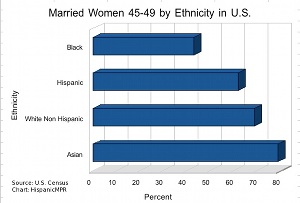
Married Women 45-49 by Ethnicity in U.S. 2008 – click on image to enlarge
Although mainstream families are showing a decline in fertility rates and as Baby Boomers age there tend to be fewer families with children 18 and under living at home, the situation is different among Latino families. In the general population the percentage of families with one or more children living at home decreased to 46 percent in 2008, from 52 percent in 1950 and 57 percent in the early 1960s, according to new data from the U.S. Census Bureau. On the other hand, 25 percent of babies and children five and under are Latino.
“Decreases in the percentage of families with their own child under 18 at home reflect the aging of the population and changing fertility patterns,” said Rose Kreider, family demographer at the U.S. Census Bureau. “In 2008, not only were Baby Boomers old enough that most of their children were 18 and over, but they were having fewer kids than their parents, as well.”
In 2008, 66.9 million opposite-sex couples lived together. Of those 60.1million were married, and 6.8 million were unmarried. At the same time, the percentage of adults ages 45 to 49 who were married varied by race and ethnicity. Among women 45 to 49, 79 percent of Asians, 69 percent of white non-Hispanics, 62 percent of Hispanics and 43 percent of blacks were married.
The census data suggests there are 25,173,000 married couples living with children or one million less than the previous year. That is the lowest number since 1999. Just over half of men and women over 18 are married and living with their spouse. People making $100,000 or more are more likely to live with their spouse, 82 percent of men and 65 percent of women.
The percentage of children living with two parents varied by race and ethnicity. Eighty-five percent of Asian children lived with two parents, while 78 percent of white non-Hispanic children, 70 percent of Hispanic children and 38 percent of black children cohabited with both parents.
Some 9 percent of all children (6.6 million) lived in a household where there was a grandparent; although for 23 percent of children living with a grandparent there was no parent in the household. In 2008, 6 percent of white non-Hispanic children lived in a household with a grandparent present, compared with 10 percent of Hispanic children, and 14 percent of both Asian and black children.
The findings come from America’s Families and Living Arrangements: 2008, a collection of 2008 Current Population Survey (CPS) statistics on family and nonfamily households, characteristics of single-parent families, living arrangements of children and data on married and unmarried couples released last week. The CPS has been conducted annually since 1940. This survey was conducted in February, March and April for a nationwide sample of 100,000 addresses.
Discover from a new mom market expert how to reach Latino moms by listening to
“Marketing to New Hispanic Moms – a case study” audio recording

Presenter Cynthia Nelson, COO, Todobebe
Find out about
• New Latina mom market
• Baby demographics including market size, profile
• New moms’ language preferences
• Latino baby market trends
• Factors influencing Hispanic baby market
• Location of new Hispanic moms’ market
• Issues affecting new Latino moms
• Todobebe strategies
Click for information on “Marketing to New Hispanic Moms – a case study”
Posted by Elena del Valle on March 2, 2009

Mexican Institute of Sound Soy Sauce album cover
Photos, song: Nacional Records, Napoleon Habeica
Mexican Institute of Sound (M.I.S.) will release Soy Sauce (Nacional Records), a new album described in promotional materials as traversing “Lara’s wild musical imagination with a witty sense of humor for good effect,” April 7. Scroll down to listen to “Alcotel” from the Mexican Institute of Sound Soy Sauce album.
Camilo Lara, known as the Mexican Institute of Sound on stage, started his artistic career creating holiday mixes for friends. Later his friends convinced him to take his songs into the studio. Four years later, Lara is launching his third album.
Soy Sauce features almost entirely original songs recorded with a live band and vocals. Holger Beier, the man behind German act Le Hammond Inferno, is the producer for the album. Beier’s contribution is most evident on a song like “Yo Digo Baila.” Lara also invited some of his musician friends to perform on the album. He recruited close friend and Tacuba’s lead guitarist Joselo Rangel to play on the tracks “Hiedra Venenosa” and “Alocatel.” From there, Ad Rock, of hip hop band the Beastie Boys, decided he wanted to remix the track “Alocatel.”

Mexican Institute of Sound’s Camilo Lara
“He helped give the songs structure and brought new flavors for my ideas,” said Lara of Holger Beier influence on his new album. “This is my most to the point dance track. I have to thank Holger for pushing me to being open minded to these sorts of ideas. What I like is that it has the sounds of cumbia but in a very radical style. When I was working on Soy Sauce, I was obsessed with Café Tacuba’s classic album Re. I wanted to record an album like that, going from polka to punk in one second. That’s why I had found it so fascinating. I wanted my album to really cover the entire scope of my musical tastes.
I’ve been friends with Mike D of the Beastie Boys for a long time. So one night after one of their shows in Mexico City, I had the group over to my place for dinner. Mike introduced me to Ad Rock and I gave him some of my music from the new album that I had been working on. Months down the line, he got back in touch, saying that he wanted to collaborate.”
Lara, the one-man musician behind Mexican Institute of Sound, is from Mexico City. He develops his music while holding down a day job. He creates his music with the help of his computer, his imagination, and his collection of vinyl. Click on the play button to listen to “Alcotel” from the Soy Sauce album

Click here to buy Soy Sauce
Posted by Elena del Valle on February 27, 2009
Information provided by our Event Partner

Voz Latina
The Latin Download: Innovations & Trends
April 23, 2009
Eden Roc Hotel – Miami Beach, FL
With the digital revolution changing the way content is developed and distributed across digital media platforms to reach 46 million Hispanic consumers, are you capitalizing on the most effective methods? Understanding the value and importance of Hispanic consumers today creates a fascinating opportunity to increase your market share and learn the best way to reach this extremely influential segment!
Don’t miss this opportunity to gain insight on how to reach the 46 million strong Hispanic population that has $900 billion in annual purchasing power.
For more information or to register, go to www.marketingtohispanics.com
HMPR Readers Save $350 off Full Price on all new registrations!
Use Promo Code: HMPR449
Posted by Elena del Valle on February 27, 2009

Who’s Buying by Race and Hispanic Origin (New Strategist, $59.95) is part of the Who’s Buying series and features 123 pages of spending information about Asian, black and Hispanic consumers in 2005. The paperback book is divided into 12 sections and four appendices.
Following a Household Spending Trends discussion for 2000 to 2005, there is an overview followed by information on spending apparel, entertainment, financial products and services, food and alcoholic beverages, gifts, healthcare, housing, and transportation shelter and utilities. There is also a section on personal care, reading, education and tobacco. The appendices address the Consumer Expenditure Survey, Mortgage Principal and Capital Improvements and Spending by Product and Service Ranked by Amount Spent.
New Strategist is a New York publishing company. Other titles published by the company include Household Spending, Who’s Buying for Travel, Who’s Buying Apparel, Who’s Buying Health Care, Who’s Buying Household Furnishings, Services and Supplies, Who’s Buying for Pets, Who’s Buying by Race and Hispanic Origin, Who’s Buying at Restaurants and Carry-Outs, Who’s Buying Transportation, Who’s Buying Groceries, Who’s Buying Entertainment, Who’s Buying by Age and Who We are Hispanic.
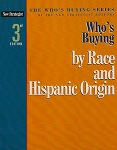
Click here to buy Who’s Buying by Race and Hispanic Origin
Comments:
Filed Under: Books
Posted by Elena del Valle on February 25, 2009
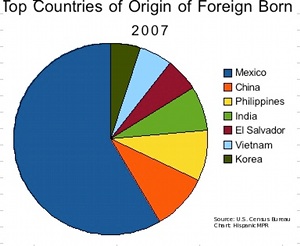
Top Countries of Origin of Foreign-Born 2007 – click on image to enlarge
There were 38.1 million foreign born people living in the United States in 2007, according to the United States Census Bureau. The agency’s new analysis of data about the U.S. foreign-born population from the 2007 American Community Survey (ACS) released last week, indicates a higher percentage of people born in India have a bachelor’s degree or higher (74 percent) than people born in any other foreign country.
Egypt and Nigeria had rates above 60 percent. Somalis and Kenyans living in the United States are the most likely to be newcomers, and Somalis are among the youngest and poorest.
Mexico is the country with the highest birth list with more than 11.7 million people. The next highest countries by birth are China (1.9 million), the Philippines (1.7 million), India (1.5 million), El Salvador and Vietnam (both at 1.1 million), Korea (1 million) as well as Cuba, Canada and the Dominican Republic.
These figures come from new detailed characteristic profiles on people who were not U.S. citizens at birth available by country of birth and their location of residence at the time of the survey.
“These new ‘selected population profiles’ highlight the diversity among the many different foreign-born groups in the United States,” said Elizabeth Grieco, chief of the Census Bureau’s Immigration Statistics Staff. “This diversity is due in part to the way the various communities were established, whether it be through labor migration, family reunification or refugee flows.”
Hispanic Marketing and Public Relations Understanding and Targeting America’s Largest Minority book

“A must resource for practitioners/professionals expecting to reach US Hispanics; also valuable for college programs in marketing, public relations and communications. Highly recommended.”
Choice magazine
Click here for information on the Hispanic Marketing & Public Relations book
In terms of education, Chinese born residents stand out. About 80 percent of the nation’s population born in China are high school graduates. In the New York metropolitan area, about two-thirds of those born in China are high school graduates, while in the metro area of San Jose, California, 93 percent were high school grads.
When it comes to earning capability among the foreign-born, people born in Somalia and the Dominican Republic had some of the lowest median household incomes; while those born in India, Australia, South Africa and the Philippines have the highest median household incomes. The median household income for U.S. residents born in India is $91,195. Median household income is $50,740 for the total population, $46,881 for the foreign-born population and $51,249 for the native population.
In terms of English language ability, 52 percent of the foreign-born population, 2 percent of the native population and 9 percent of the total U.S. population speak English less than “very well” while 97 percent of the foreign-born population from Mexico and the Dominican Republic age 5 and over speak a language other than English at home. Those born in Nicaragua, El Salvador, Armenia, Honduras, Bosnia and Herzegovina, and Ecuador also have high rates of speaking a language other than English.
People from Mexico, Guatemala, Honduras and El Salvador age 5 and over are most likely to speak English less than “very well.” More than 70 percent of the foreign-born population from these countries identified themselves in that category.
Foreign born respondents were more likely to suffer from poverty than U.S.-born respondents of the survey. Overall, about 13 percent of natives and the total U.S. population are living in poverty, while about 16 percent of the foreign-born are poor. About 51 percent of residents born in Somalia live in poverty. About a quarter of the population born in Iraq, the Dominican Republic, Jordan and Mexico are also living in poverty.
The 2007 ACS estimates are based on a nationwide sample of about 250,000 addresses per month as well as 20,000 group quarters across the United States that were sampled, comprising approximately 200,000 residents. Geographic areas for which one-year data are available are based on total populations of 65,000 or more.
Federal officials rely in part on the data collected by the ACS to determine where to distribute more than $300 billion to state and local governments each year. Responses to the survey are confidential and protected by law.
“Best in Class Hispanic Strategies” audio recording


Presenters Carlos Santiago and Derene Allen
-
Find out what makes 25 percent of the top 500 Hispanic market advertisers out perform the remaining companies
-
Discover what questions to ask, steps to take to be a Best in Class company
Click here for more about “Best in Class Hispanic Strategies” audio recording
Posted by Elena del Valle on February 23, 2009
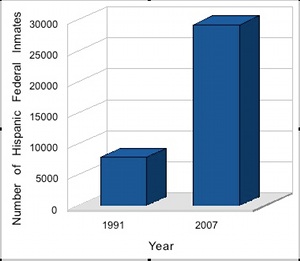
Number of Hispanic Federal Inmates – click on image to enlarge
An increase in illegal immigration over the years and the federal government’s recent enhanced surveillance of our borders have resulted in a significant increase in Latino inmates in federal prisons. Although Latinos only represent a fraction of the national population, they are overrepresented in federal prisons.
In 2007, 40 percent of prisoners convicted of federal crimes were Latinos. One third of federal prison inmates are Latino, making that ethnic group the largest in the federal prison system, according to a recent study. Between 1991 and 2007 the number of inmates at federal prisons doubled and the number of Latino inmates quadrupled increasing from 7,924 to 29,281.
It’s noteworthy that 72 percent of Latinos in federal prisons are not U.S. citizens and most were jailed as a result of sentences in courts from one of the states bordering Mexico. It’s not surprising then that almost half, 48 percent, of Latino federal inmates were convicted of immigration related violations. The second most common cause of incarceration was drug convictions, according to a Pew Hispanic Center study released last week.
The Pew Hispanic Center, a nonpartisan research organization, is dedicated to improving public understanding of the Hispanic population in the United States and to chronicle Latinos’ growing impact on the nation. It does not take positions on policy issues.
“Marketing to Multicultural Kids” audio recording

Michele Valdovinos gives a presentation and participates in an extended Q&A discussion about multicultural children based on a Phoenix Multicultural and Nickelodeon study of 1,300 multicultural children in 16 United States markets.
Find out about
• The Phoenix Multicultural Kids Study
• Relationship between children and their context
• Issues relating to family, technology and media, diversity, buying power, relationships in household, self perception, values, acculturation, cultural heritage, frequency of media activity, income and spending, brand preferences, the American Dream
• How many billions of dollars buying power multicultural kids children have
• Children’s spending attitudes, habits by ethnicity
• How much money a year Hispanic kids have available to spend
• Types of products Hispanic kids buy
Click here for information on “Marketing to Multicultural Kids” audio recording
Posted by Elena del Valle on February 20, 2009
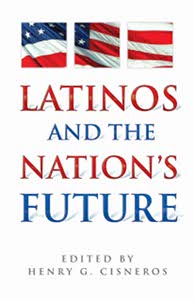
Latinos and the Nation’s Future book cover
Photos: Arte Publico Press
In Latinos and the Nation’s Future (Arte Publico Press, $29.95) 15 individuals, 11 men and four women, share their thoughts about Latinos in the United States. Each writer contributed one chapter, except Nicolas Kanellos, Ph.D. who contributed two chapters. The 248-page hardcover book was edited by Henry G. Cisneros, chairman of American CityVista, and John Rosales, co-editor of Casa y Comunidad: Latino Home and Neighborhood Design (Builder Books). Cisneros also contributed the first chapter, An Overview: Latinos and the Nation’s Future.
The book is divided into four parts: Latino Visions: Past, Present and Future; Latinos and the Larger Society; Raw Numbers and Their Impact; and Final Thoughts. In addition to Cisnero’s overview the first section includes three chapters: The Latino Presence: Some Historical Background by Nicolas Kanellos, Ph.D., founder and publisher, Arte Publico Press; Liberty and Justice for All: Civil Rights in the Years Ahead by Raul Izaguirre, executive director, Center for Community Development and Civil Rights at Arizona State University; and Becoming American – The Latino Way by Tamar Jacoby, president and chief executive officer, Immigrationworks USA.
The second section is divided into six chapters: Increasing Hispanic Mobility into the Middle Class: An Overview by Harry P. Pachon, Ph.D., professor of public policy, University of Southern California; Latino Small Business: A Big Present, A Bigger Future by Aida M. Alvarez, board member of Wal-Mart and Union BanCal Corp/Union Bank of California; Making the Next Generation Our Greatest Resource by Sarita E. Brown, president, Excelencia in Education; La Gran Oportunidad Up for Grabs The Hispanic Opportunity by Joe Garcia, a former Democratic candidate for Congress in South Florida; Politics and the Latino Future: A Republican Dream by Lionel Sosa, an advertising executive; and Latino Progress and U.S. Foreign Policy by Sergio Muñoz Bata, a journalist.
Part three of the book includes four chapters: The Raw Numbers: Population Projections and the Power of Hispanic Demographic Change by Leobardo F. Estrada, Ph.D., associate professor, UCLA School of Public Affairs; Latino Numbers and Social Trends: Implications for the Future by Roberto Suro, professor of journalism, University of Southern California Annenberg School for Communication; A First-Order Need: Improving the Health of the Nation’s Latinos by Elena V. Rios, M.D., M.S.P.H., president and chief executive officer, National Hispanic Medical Association; and Housing the Nation’s Latinos: An Overview by Saul N. Ramirez, Jr., executive director, National Association of Housing and Redevelopment Officials.
The final section only has two chapters: On the Power of Education and Community Action by Ernesto Cortes, Southwest regional director, Industrial Areas Foundation; and Toward the New American Dream by Kanellos.

Henry G. Cisneros
Cisneros is a former Secretary of the U.S. Department of Housing and Urban Development and former mayor of San Antonio, Texas. Previously, he was president and chief operating officer, Univision Communications in Los Angeles, California. He has a doctorate degree in public administration from George Washington University.

Click here to buy Latinos and the Nation’s Future
Comments:
Filed Under: Books
Posted by Elena del Valle on February 18, 2009
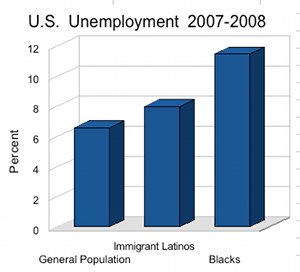
Click on image to enlarge
Although the economic recession is impacting everyone, it seems Latino immigrants, blacks and native-born Hispanics have been more severely affected than the rest of the population. While blacks are the only group with an unemployment rate in the double digits, 11.5 percent; in the fourth quarter of 2008, 9.5 percent of U.S.-born Hispanics were unemployed.
From the last quarter of 2007 to the last quarter of 2008, unemployment in general market increased 2 percentage points, from 4.6 percent to 6.6 percent. The unemployment rate for foreign born Latinos rose by 2.9 percentage points (from 5.1 percent to 8 percent) for the same period.
At the same time, the number of employed immigrant Latinos of working age dropped 2.8 percentage points from the last quarter of 2007 to the last quarter of 2008 (from 67.5 percent to 64.7 percent); compared to a 1.6 percentage point drop in the employment rate among the general working age population (from 63.2 percent to 61.6 percent).
These are the conclusions of Rakesh Kochhar, associate director for Research, Pew Hispanic Center in an article published last week, Unemployment Rises Sharply Among Latino Immigrants in 2008. He relied on data from the Current Population Survey, a monthly survey of 55,000 households conducted jointly by the Bureau of Labor Statistics and the Census Bureau.
The Pew Hispanic Center, a nonpartisan research organization, is dedicated to improving public understanding of the Hispanic population in the United States and to chronicle Latinos’ growing impact on the nation. It does not take positions on policy issues.
Reach Hispanics online today with
“Marketing to Hispanics Online” audio recording
Identifying and characterizing the booming Hispanic online market



Joel Bary, Alex Carvallo and Matias Perel
Find out about
• The 16 million Latino online users
• Latino online users by gender
• What they do online
• Their language preferences
• How to reach Hispanic urban youth online
• What affects their online behavior
• What influences their purchases
Click here for information about “Marketing to Hispanics Online”
Posted by Elena del Valle on February 16, 2009

Click on image to enlarge
Does your mailbox look less full lately? One reason might be that the number of credit card offers has decreased significantly in the last year, especially for households with incomes below $100,000 a year. New data from Mintel Comperemedia, a leading market research company, indicates only 5.4 billion credit card direct mail offers were sent to Americans in 2008, the lowest annual total reported since 2000.
In 2008, most credit card issuers decreased their direct marketing mailings significantly, resulting in a new card mail volume decline of 26 percent compared with the previous year. Researchers estimate 2007 mail volume at 7.4 billion or 36 solicitations per household, and at 8.3 billion in 2006.
The decrease in offers may be the result of the weak economy as well as the hundreds of consumer complaints against credit card issuers. From poor performers to stellar credit holders, people across the country have been complaining for months about credit card company abuses including sudden rate hikes, changes in terms with little or no advance notification, as well as increasing late fees and minimum service charges.
According to the Consumer Federation of America, the average credit card debt per household is $7,430 and 35 percent of accounts are incurring late fees. There are those who argue that credit card companies are in trouble, having oversold their product. Unable to find a way to sell their debt to investors some credit card issuers are requesting federal rescue monies.
Mail offers sent for new credit cards dropped steadily throughout 2008. There was an 8 percent decline from Q1-Q2 and a 13 percent decline from Q2-Q3. The last quarter of 2008 had the most remarkable quarterly drop, 33 percent compared to the previous quarter.
“With reduced funds available for lending and increased loan losses, credit card issuers had no choice but to drastically cut direct marketing for new cards during 2008. Credit card issuers shifted direct marketing strategy to focus on higher earning, lower risk consumers. 2008 was an adjustment year for the credit card industry as issuers were confronted with economic conditions not seen in decades,” said Stephen Clifford, vice president of Financial Services at Mintel Comperemedia. “In 2009, I expect less volatile fluctuations in mail volume as the industry positions itself to ride out the recession and recover.”
Although a breakdown by ethnic group was unavailable, it is noteworthy that while estimated direct mail volume for credit card acquisition fell across the board last year, individuals with the highest incomes saw little change in their mailboxes. According to Mintel Comperemedia, households with an income in excess of $100,000 a year received only 1 percent fewer credit card offers in 2008 than in 2007. At the same time, households making $50,000 or less saw a 42 percent drop in new credit card mail volume.
Based on that data, perhaps we can conclude that Latinos with incomes above $100,000 continued receiving an almost unchanged number of credit card offers while those with incomes below $50,000 saw a significantly lower number reach their mailboxes.
“Best in Class Hispanic Strategies” audio recording


Presenters Carlos Santiago and Derene Allen
-
Find out what makes 25 percent of the top 500 Hispanic market advertisers out perform the remaining companies
-
Discover what questions to ask, steps to take to be a Best in Class company
Click here for more about “Best in Class Hispanic Strategies” audio recording
Posted by Elena del Valle on February 13, 2009
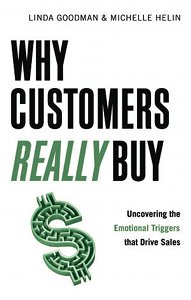
Why Customers Really Buy: Uncovering the Emotional Triggers that Drive Sales book cover
Photos: Career Press, EvinThayer
A newly published book written for sales and marketing professionals addresses issues relating to the emotional triggers the authors believe are behind shoppers purchasing behavior. In a jointly written book, Why Customers Really Buy: Uncovering the Emotional Triggers that Drive Sales (Career Press, $14.99), Linda Goodman and Michelle Helin, business consultants with decades of experience advising Fortune 500 companies, discuss specific and practical guidelines to illustrate how “insights can become useful for converting emotional considerations into actionable solutions.”
They believe that the same emotional motivation that drives consumers to loyally purchase brand products applies to the business to business environment. They explain that unlike other popular methodologies that focus on mapping emotional reactions against existing products or communications messages, Emotional Trigger Research is a proactive technique designed to uncover the core, unfiltered, and spontaneous triggers that drive actions.
They are convinced that these triggers reveal insights that can be useful in creating sales and marketing strategies that may transform companies. The process relies on a combination of questions, listening, and in-depth conversations, to identify the information companies seek.
The 256-page paperback includes local, national and international case studies and is divided into five parts: Discovering the Power of Emotion, Putting Emotional Triggers to Work – Sales, Putting Emotional Triggers to Work – Marketing, Putting Emotional Triggers to Work – Customer Relationships, and Integrating Emotional Logic.

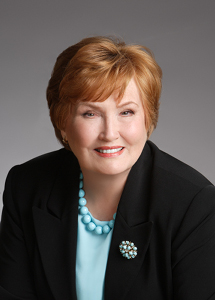
Linda Goodman and Michelle Helin, coauthors, Why Customers Really Buy
Goodman and Helin are independent business consultants who have served as senior sales and marketing officers for Fortune 500 corporations within the hospitality, entertainment, and retail sectors. Past clients, in the United States and around the world, include AT&T Lucent Technology, Schlumberger LTD, GE Corporation, Compaq Computer, Omnicom Group Inc., Staples, Tribe Pictures, and Disney. Goodman’s business, LG Associates, is based in Avon, Connecticut. Helin’s company, Michelle Helin LLC, is based in Houston, Texas.

Click here to buy Why Customers Really Buy: Uncovering the Emotional Triggers That Drive Sales



































